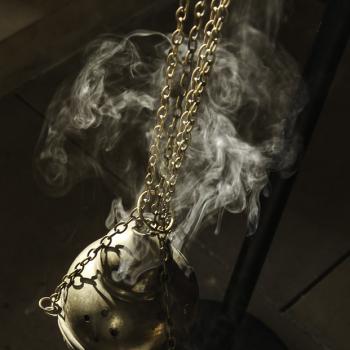A lot of people have wondered. Last weekend, when someone asked about it, my pastor joked, “You want to know? Check ‘The Deacon’s Bench’!”
Heh.
I was curious myself, and after digging through mounds of meaningless googling which said, again and again, “It’s because we rejoice,” I dug up this explanation, which is one of the best I’ve found. It comes from Br. Hyacinth Marie Cordell, OP:
To understand the meaning of rose, we first need to be aware of a certain liturgical principle, here expressed in the words of Dr. Pius Parsch:
“Nature’s annual cycle is characterized by two phenomena, light and life. Out of the darkness of night comes light; out of death comes life. The transition from night to light characterizes the winter season; the transition from death to life is proper to summertime. The holy year of the Church is likewise divided into two phases which have similar characteristics.”
In other words, nature and the mysteries of our salvation coincide. The dark color of violet in Advent harmonizes well with the diminishing sunlight late in the year, and in Lent with the silence of life through Winter leading up to Spring. In both cases, we see a parallel. Just as darkness gives place to light at the turn of the Winter Solstice and death to life at the beginning of Spring, so the violet of Advent gives place to the bright white of Christmas joy, and of Lent to the brightness of Easter life. “But wouldn’t black be more appropriate as a color of darkness and death?” someone might wonder. Ah, here again we encounter the Church’s wisdom! Black is the absence of all color and light. But as “children of the light,” we are never in complete darkness. “The light shines in the darkness, and the darkness has not overcome it.”
Even in funeral liturgies where priests can wear black as a symbol of mourning, the liturgy speaks of light: “let perpetual light shine upon them.” Violet is a dark and penitential color, but it is also the ancient color for royalty and wealth. Through baptism, we have been immersed in Light and Life, and we have been given the royalty of being children of the King of Heaven! So, violet expresses well both these aspects: darkness and royalty.
With this dramatic backdrop, we can understand the rose color of Gaudete and Laetare Sundays and the hidden lesson contained here for us. Rose is a softening of violet. It is violet approaching white. In this sense, it anticipates the pure white of the Birth and Resurrection of Christ. It intimates the mystery of the “already, and not yet” of Christian life. The Messiah has come. We have been redeemed. We have been washed. We have been sanctified. The Light that is God has come to dwell in our souls. The Father “has delivered us from the dominion of darkness and transferred us to the kingdom of his beloved Son, in whom we have redemption, the forgiveness of sins.” And yet, we wait for Christ to come. We wait for eternal life. We wait for “the redemption of our bodies.” We are still in a “valley of tears.” “For now we see in a mirror dimly, but then face to face.”
There’s much more, along with footnotes, here.












